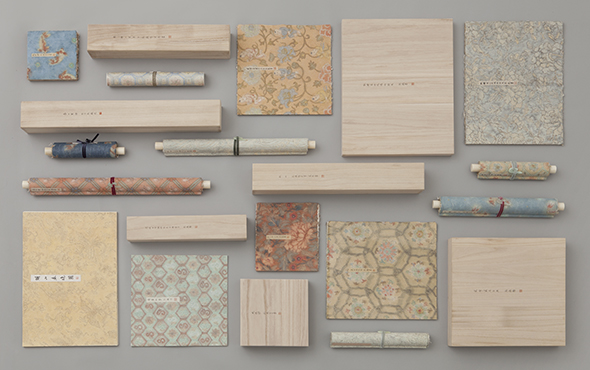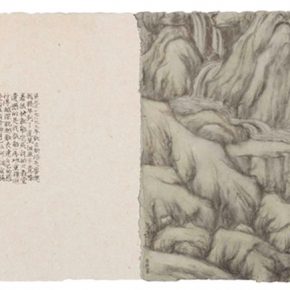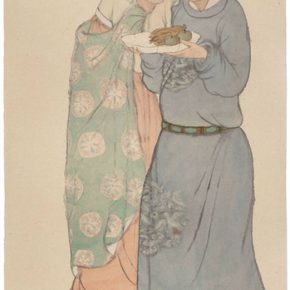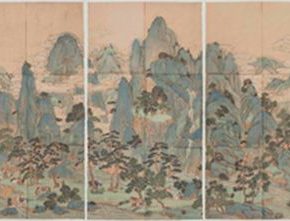
Following the exhibition Italian Renaissance Drawings from the British Museum, the Suzhou Museum’s Contemporary Art Gallery will house a poetic and modern exhibition by artist Peng Wei. Her fifty-plus works in ink from the past five years are choreographed into a space of gardens meticulously crafted by famed architect I. M. Pei to beckon a dialogue on East-West amalgamation.
Organized by the Suzhou Museum and co-organized with the Beijing Fine Art Academy and TKG Foundation for Arts & Culture, this exhibition is curated by Wu Hongliang, Director of the Beijing Fine Art Academy, and marks the debut of Peng Wei’s latest series “Song of Sings.” It is also the most audacious exhibition ever mounted in the museum’s Contemporary Art Gallery. The entire space is cocooned in translucent fabric and divided into seemingly endless sections. Much like unraveling a mystery, visual illusions rendered through acts of concealing, guiding, or twining usher the viewer into the depths of the exhibition, where, varying from the traditional Chinese garden scenery, “a different view with every step” unfolds.
The exhibition space is designed by Mr. Keisuke Toyoda of the Japanese design studio Noiz Architects. It is the second collaboration between Mr. Toyoda and Peng Wei. Grounded in Peng Wei’s “Good Things Come in Pairs” series of silk shoe installations, and inspired by the winding paths of Suzhou gardens, as well as the geometric lines in I. M. Pei’s design of the Suzhou Museum, this exhibition is divided into the Garden, the Journey, and the Temple.
On display in the Garden section are “Here's by Chance” paintings from the “Lost Stones” series, and such delicate landscape albums as “The Best Things in Life Are Free.” Much like watching mountains, the pleasure of watching rocks abounds whether the watcher stands near or far. Through a dispersed arrangement, a labyrinthine flow through the museum is conceived that lends a three-dimensionality to an array of two-dimensional paintings, at the same time playfully echoing the flattened faux mountains and rocks in the Suzhou Museum.
In the Journey section, daylight is dexterously harnessed, a stretching arc created with translucent curtains, conjuring a flow without end that parallels the scrolls from the series “Letters from a Distance” and silk shoe painting installations from the series “Good Things Come in Pairs.” Various six-meter-long scrolls exquisitely rendered in ink, and love scenes cradled in silk vessels provide the viewer with intense information and a different view with every step.
Peng Wei incorporates a plethora of letters by Western authors and artists into the “Letters from a Distance” series, in place of the traditional inscription in Chinese classical painting. Seen in the works in this exhibition, Susan Sontag’s letter to Jorge Luis Borges discusses the disappearing of books and the struggle between eternity and the present, while the story about Olympia serves as the Impressionists’ voice of indignation on the injustice that Édouard Manet suffered, and as a discussion on the prejudice in the art history. Both exemplify the kind of themes that deeply concerns Peng Wei. The West is the East. The end is the beginning. The vicissitudes of life, the mysteries of civilizations, and the philosophical ponderings in Peng Wei’s work blend together in the intertextual space with a lingering poignancy.
Debuting in the Temple section, Peng Wei’s latest portrait series “The Song of Sings” marks her first attempt at portraying figures in ink on a large scale. This series is inspired by the garden culture of Suzhou. “The common thread that runs in my past body of work is the relationship between objects and figures. I tend to highlight the materiality of painting. Whether it’s memories evoked by a memento, or sorrows elicited from old trinkets of people now gone, objects project all kinds of human emotions and man’s destiny.” In the “Letters from a Distance” series, the human figure is simply a minuscule existence amid mountains and valleys, but now the human figure has been illuminated and placed in the foreground.
Who comes to mind when you see the title “When I Thought of You”? Peng Wei’s work is grounded in the universality of human emotions. Despite the anonymousness of the common people she portrays, these subjects’ emotions — friendship, longing, solitude, content, or melancholy — are universal, even with a pinch of Pop art sense of humor. The history of civilizations sees humanity derive from divinity; hence humanity should be treated equal as divinity. At the end of the gallery hall, these sentient beings are juxtaposed with large-scale installations in the Temple, which is cocooned in pristine white curtains, telling the stories of human and all living things, of man and gods, in all their ordinariness and grandeur.
The TKG Foundation for Arts & Culture cordially invites you to visit Suzhou in the New Year, immersed in the refinedness and sophistication of Peng Wei’s work.
About the exhibition
Dates: Jan 15, 2017 - Mar 12, 2017
Opening: Jan 14, 2017, 15:30, Saturday
Venue: Suzhou Museum
Courtesy of the artist and Suzhou Museum, for further information please visit www.szmuseum.com.

















































